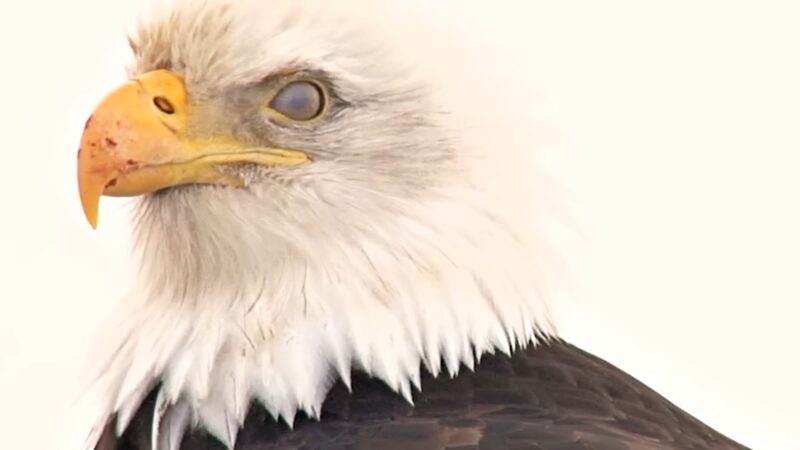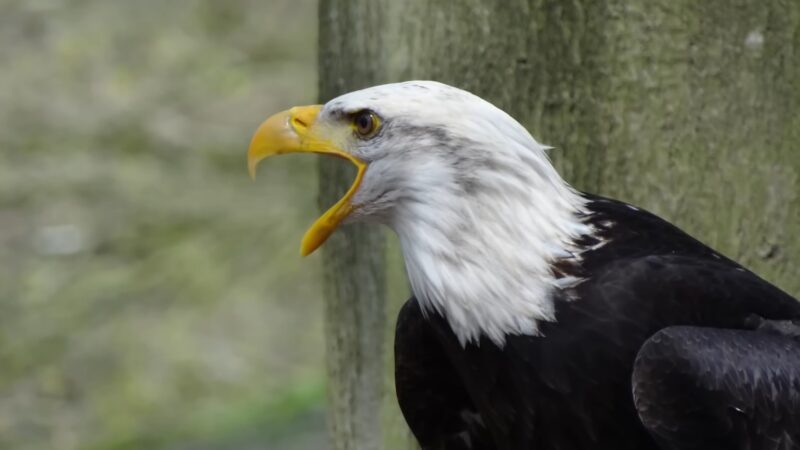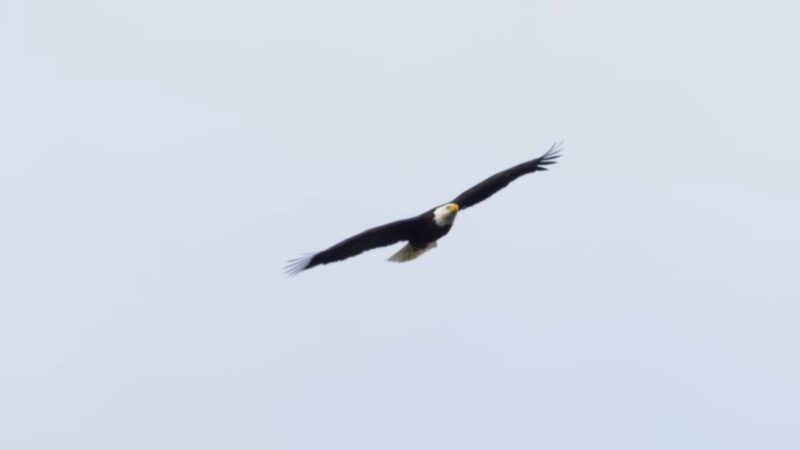Bald Eagles are majestic creatures that grace the skies with their soaring flights and capture our fascination with their regal presence. Emblazoned on our national seal, these birds of prey have become a potent symbol of freedom.
This blog aims to delve deeper into the intriguing world of Bald Eagles, focusing on the key differences between male and female specimens. The ability to distinguish between the specimens not only enhances our appreciation of these magnificent birds, but also provides essential insights into their behavior, social structure, and conservation.
Each facet of their lives provides a glimpse into their unique behaviors and the intriguing differences between the sexes.
Size and Physical Appearance

One of the most notable differences is their size. Contrary to what we often see in the animal kingdom, it is the female Eagle that is typically larger than her male counterpart.
The female can stand up to 37 inches tall and possess a wingspan of up to 90 inches, whereas the male typically reaches a height of about 35 inches, with a wingspan of around 80 inches. Female Bald Eagles also tend to be heavier, with their weight ranging between 10 to 14 pounds, while males weigh between 7 to 10 pounds.
Interestingly, this size discrepancy, known as sexual dimorphism, is common in raptors and is thought to have evolved due to the differing roles of males and females. For instance, the larger size of the female may enable her to provide better protection for their young.
The males, on the other hand, being smaller and lighter, can fly faster and more agilely, making them efficient hunters. Although the size difference is a reliable indicator, it’s important to note that size can vary among individual eagles, influenced by factors such as genetics and geographical location.
Consequently, size should be used in conjunction with other physical and behavioral characteristics to accurately determine the sex of a Bald Eagle.
Plumage Coloration and Patterns
When it comes to plumage, both sexes share the iconic brown body and white head and tail, a mature coloration they acquire around the age of five. Juvenile Bald Eagles of both sexes sport a mottled brown and white appearance until they reach this age.
Therefore, plumage coloration does not serve as a useful distinction. However, slight variations in color intensity and feather patterns might be observed, depending on individual characteristics and lighting conditions.
For instance, females may sometimes exhibit a slightly darker hue, particularly around the edges of their white head and tail feathers. It’s also thought that males may have a slightly sleeker appearance due to their smaller size.
In conclusion, while the plumage coloration and pattern are largely identical in males and females, careful observation might reveal subtle differences. Yet, it remains a challenge to distinguish the sexes solely based on their feathers.
Beak Shape and Size

Bald Eagles have large, powerful beaks perfectly adapted for their predatory lifestyle. The beak serves multiple purposes—it’s used for tearing flesh from their prey, preening feathers, and even as a tool during nest construction.
Like many other physical characteristics, the beak size of Bald Eagles exhibits sexual dimorphism. Typically, females have larger beaks compared to males, reflecting their overall larger body size.
The depth of the beak—from the top of the beak to the chin—can be noticeably greater in females. This characteristic, however, can be challenging to discern unless the birds are in close proximity to each other or the observer has significant experience.
It’s essential to remember that the size of the beak, like other physical characteristics, can also be influenced by individual genetics and regional differences among Bald Eagle populations. Therefore, while beak size can provide clues about the bird’s sex, it should be used cautiously and in conjunction with other identifying features.
Eye Color
These birds have strikingly intense eyes that play a critical role in their exceptional visual acuity. This enables them to spot potential prey from great distances while soaring high in the sky. Both male and female birds possess similar eye color—bright, pale yellow which is not a distinguishing factor.
The eye color of juveniles is darker, often a gray-brown, and lightens as they mature. The size of the eye can sometimes provide hints about the sex of the bird. In line with the general size difference, the eyes of females tend to be slightly larger.
However, unless you can examine the bird up close, this difference can be challenging to discern. Given the subtle nature of these differences, eye color and size are generally not used as reliable indicators to distinguish between the sexes. Instead, behavior, size, and vocal differences tend to be more accurate markers of gender.
Vocalizations and Calls

Both sexes possess a range of calls used for communication and territorial displays. Their iconic screaming call, often heard in movies (though it’s usually a red-tailed hawk call used for the sound effect), serves as a territorial assertion and can carry across long distances.
While both sexes share similar types of calls, there’s a noticeable difference in the pitch. Male birds typically have a higher pitch compared to the females. The reason for this variance may be related to their size difference—similar to many animals and even humans, smaller creatures often have higher pitched voices.
Listening to their calls can thus provide an auditory clue to their sex. However, unless you have a trained ear or the two sexes are calling in comparison, this difference can be challenging to distinguish.
Also, individual variations and overlapping pitch ranges between some males and females may complicate identification.
Nesting and Courtship Behavior
When it comes to nesting and courtship, the two sexes exhibit distinctive roles and behaviors. Both of them participate in building the nest—an impressive structure that can reach up to 10 feet wide and weigh half a ton.
However, the female often plays a more dominant role in shaping the nest interior, where she will lay the eggs. Courtship displays involve intricate aerial maneuvers, such as the famous “cartwheel” display where two eagles lock talons and spiral toward the earth.
These displays help to strengthen the bond between the pair and establish territory. During incubation, both sexes share the duty, but the female typically spends more time on the nest. Territorial defense is also crucial during the nesting period.
While both sexes defend the territory, males are often seen taking a more active role in perimeter defense and keeping potential threats at bay.
Hunting and Feeding Habits
Hunting and feeding habits can provide further insight into the gender differences of these remarkable birds. Eagles are skilled hunters and their diet primarily consists of fish, but they will also feed on small mammals, birds, and carrion.
While both males and females actively hunt and fish, studies have shown that females, due to their larger size, can potentially capture larger prey than males. Males, on the other hand, might engage more frequently in opportunistic feeding and scavenging behavior due to their smaller size and lower energy needs.
Additionally, during the nesting season, males often take on the primary role in providing food for the nest. This might involve more frequent but smaller prey deliveries to the nest, while the female takes the main role in feeding and tending the chicks.
Life Expectancy and Maturity
Male and female Bald Eagles share similar life expectancies. In the wild, they can live up to 20 years, and in captivity, where threats and food scarcity are absent, they can live up to 50 years. However, the maturity rate slightly differs between the two genders.
Female birds typically mature and start breeding at around four to five years of age, while males may start breeding a bit later, around five to six years. This subtle difference in maturity rates can have important implications for the eagle’s life history traits, including mating and reproduction.
Additionally, adult survival rates tend to be higher than those of juveniles, with both sexes experiencing a surge in survival rates once they reach breeding age, mainly due to their gained experience in hunting and increased capability to defend against predators.
Territory and Home Range

Both sexes are territorial, but the size of the territory they establish can depend on a variety of factors, including availability of prey, location, and population density. While both of them defend their nesting territories, males are often more active in perimeter patrols and defense against intruders.
Female eagles, due to their larger size, may focus more on guarding the nest directly and maintaining the nest structure. In terms of home range, it can be challenging to discern a clear difference between the sexes, as the size of a Bald Eagle’s home range largely depends on the abundance and distribution of food resources.
When it comes to travelling, Bald Eagles can travel extensive distances outside their territorial boundaries in search of food, particularly in the non-breeding season, regardless of their sex.
Parental Care and Offspring Rearing
These birds exhibit remarkable parental care, with both males and females sharing responsibilities. However, roles can differ slightly between genders, adding another layer of distinction to their behaviors.
Typically, both parents share incubation duties, but the female spends more time on the nest, owing to her larger size and ability to provide better insulation. During this period, the male plays a crucial role in providing food for his mate and later for their chicks.
Once the eggs hatch, the female often takes the lead in feeding the young, tearing off small pieces of food brought by the male to feed to the chicks. As the chicks grow, both parents assist in the feeding process, teaching the young how to eat.
Migration Patterns

Migration patterns of male and female Bald Eagles can be quite similar. However, certain studies suggest that younger females might migrate earlier and farther than their male counterparts. This could be due to the females’ larger body size requiring more resources, forcing them to seek new feeding grounds.
Eagles of both sexes tend to follow the same migratory routes year after year, often returning to the same wintering grounds. Their routes are heavily dependent on food availability and weather conditions, which can lead to variations in the distances travelled and the time of year migration begins.
Despite these potential differences, both sexes share the common goal of migration: survival during the winter months when food resources in their breeding territories become scarce.
Conservation Status and Population Dynamics
Understanding the differences between male and female specimens also extends to their conservation status and population dynamics. Historically, Bald Eagles faced severe population declines due to pesticide exposure, habitat loss, and human persecution.
However, thanks to rigorous conservation efforts, the species has made a significant recovery. As with many raptor species, these birds exhibit a slightly skewed sex ratio favoring females. This could be attributed to the fact that female eagles generally have a higher survival rate because of their larger size, providing them with an advantage in food competition and predator defense.
Human activities continue to pose threats to both sexes, and their conservation status is still closely monitored. It is crucial to understand the different roles and characteristics of male and female Eagles to manage and preserve these birds effectively.
FAQs:
Are there differences in the aggression levels between the sexes during territorial disputes?
Both sexes can display aggression during territorial disputes, with no significant differences observed in their behavior.
Can the gender be determined by the nest size?
Nest size alone cannot determine the gender of a bald eagle. The size of the nest can vary based on factors such as environmental conditions and the experience of the nesting pair.
Are there differences in the size of talons?
Both male and female bald eagles have similarly sized and powerful talons, which they use for catching and gripping prey.
Can you visually determine the gender of a bald eagle in flight?
It is challenging to determine its gender in flight based solely on visual cues, as their size and plumage differences are more apparent when they are perched.
Are there differences in the timing of breeding seasons between these birds?
Male and female specimens follow a similar breeding season timeline, typically starting in late winter or early spring.
Conclusion
In conclusion, male and female Bald Eagles exhibit a range of fascinating differences, from physical characteristics to behavior and life history traits. Understanding these differences is not just essential for bird enthusiasts, but for conservation scientists working to protect and preserve this magnificent species.
While both sexes share common features like body shape and coloration, and the iconic white-headed, yellow-beaked appearance, subtle differences like size, beak shape, and behavior patterns help us tell them apart.
The more we know about these incredible birds, the more we can do to ensure their survival and preservation for future generations to behold. The majestic Bald Eagle – male and female alike – never ceases to capture my attention and admiration
Related Posts:
- Spot The Difference Between A Male and Female Bear
- What Is the Difference Between a Coyote and a Wolf?…
- What Is the Difference Between Insects and Spiders?…
- Do Female Deer Have Antlers? - A Rare and Remarkable Feature
- What Are the Predators of Eagles? -Surprising…
- Top 11 Climate Deniers: Key Players Revealed








